


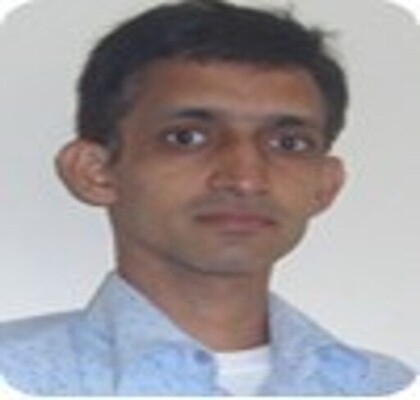
Associate Professor
Publications
Group Members

SRF

JRF
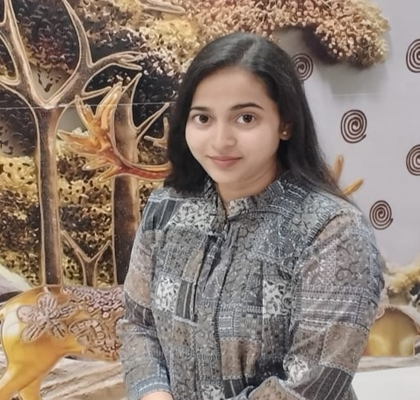
JRF

JRF
Scientific goals and achievements
Metal free organic emitters for OLED application: Organic light-emitting diode (OLEDs) composed of fluorescent materials show emission from recombination of singlet excitons, while, those utilizing phosphorescent materials harvest both singlet (S1) and triplet (T1) excitons. Development of efficient and cost-effective phosphorescent materials for entire visible region is still challenging due to poor colour purity and their high cost. In our group, we aimed to develop metal free organic emitters for efficient OLEDs. Followings are the selected research projects undertaken in last few years:
(1) Excited state dynamics of bay and peri aryl substituted perylene derivatives: Even though photodynamics of perylene has been studied in depth, its bay and peri aryl substituted derivatives have not been studied to that extent. To study the effect of aryl substituents on the ultrafast photodynamics, positional isomers of aryl substituted perylene (at bay and peri positions) were synthesized and dynamics of excimer formation and its further dissociation was studied using benzothienyl substituted perylene. We also studied the effect of substituents on the exciton diffusion rate in nanoaggregates. The bay isomer showed relatively longer diffusion length (~ 32 nm) than peri isomer (~19 nm). We also synthesized the PDI and benzocoronenediimide (BCDI) derivatives to study their photophysical properties. Rare emissive H-aggregates were observed in BCDI derivative. The tertiary butyl groups are placed to inhibit the formation of strong aggregates. A blue shift in absorption and weaker but red-shifted emission is observed for aggregate than monomer. An extraordinarily long emission lifetime from the H-aggregated state is observed.
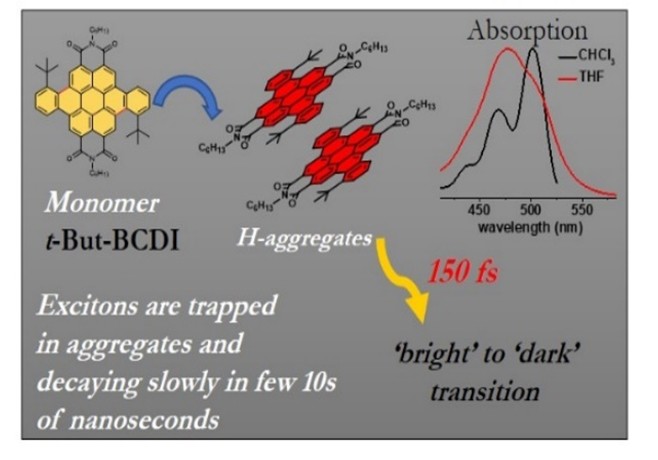
Publications: J. Photochem. Photobiol. Chemistry A, 447, 2024, 115179; J. Phys. Chem. C, 125, 2021, 20405; J. Phys. Chem. B, 126, 2022, 5908 and Phys. Chem. Chem. Phys., 27, 2025, 175-181.
(2) Modulation of ΔEST and room temperature phosphorescence in carbazole derivatives: A simple strategy to modulate the singlet-triplet energy gap in 3,6-diaryl-N-acetophenylcarbazole derivatives is developed. Different substituents significantly influenced ΔEST which is correlated for the first time with the singlet-triplet excited state dipole moments. EST has inverse relation with the difference in singlet-triplet dipole moment (ST). Broad emission in the powder form at ambient conditions is observed with long lifetime upto 248 s. Ultralong emission lifetime (up to 2.2 s) at 77 K is also observed.

Publications: Chemical Communications, 60, 1408-1411, 2024 (Cover Artcile)
(3) Ultralong room temperature phosphorescence in halogen free carbazole derivatives: Development of metal and halogen-free organics for persistent luminescence and RTP have been envisaged through aggregation, heavy atom substitution, host–guest interactions etc. In this work, we studied the experimental evidences for the effect of H-bonding and other non-bonding interactions on types of emission in five carbazole derivatives. N-aryl substituted carbazole derivatives showed dual emission consisting of fluorescence and phosphorescence in powder under ambient conditions with long life time upto 1.2 ms in powder form. Further, persistent luminescence having lifetime up to 1.5 s at ambient conditions in drop-casted doped PVA films.
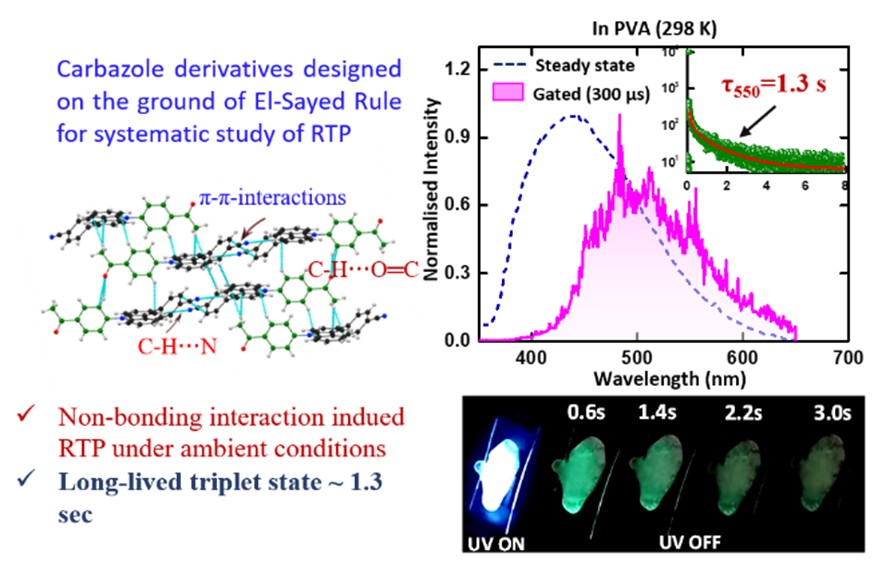
Publications: J. Phys. Chem. C, 2025, DOI: 10.1021/acs.jpcc.4c06442
(4) Dual emission, afterglow at 77K, and impressive EQE of 19% from its host-guest OLED: In order to have efficient OLED emitter with less efficiency roll-off, we designed xanthone -amine derivative (Xan-Azepine) with twisted electron rich dibenzoazepine having limited rotation at donor-acceptor bond. Xan-Azepine showed solvent polarity dependent fluorescence in a range of 441 to 597 nm having lifetime below 10 ns. At 77K in Me-THF, triplet at 557 nm was observed having a decay lifetime of 0.75 s and an afterglow for about 6 s. Its blend in CBP showed delayed fluorescence with a lifetime of 118 µs at 300K while it reduced to 84 µs at 150K suggesting TADF nature of Xan-Azepine. In doped films of Xan-Azepine (5 wt %) with CBP, a maximum luminescence of 5,980 Cd/m2 at a current density of 70 mA/cm2 was obtained resulting in a EQEmax of 19% with a low efficiency roll off (2.75%) at higher brightness.
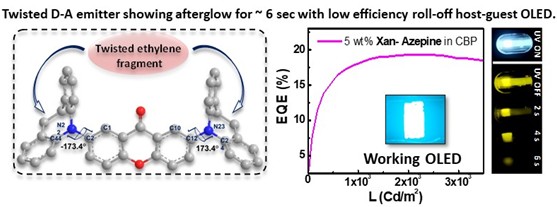
Publications: ACS Applied Mater. Interface, 16, 45, 62446-62455, 2024.
Materials for applications in organic electronics and biological applications: PDT relies on many factors and one of them is high singlet oxygen generation ability of PS in aqueous medium and absorption of PS in therapeutic window. We focus on achieving both these features in PS along with cytotoxic studies in cancer cells at low concentration and low light dose.
(5) Near Infra-red absorbing metal free BF2 chelates: In this work, we aimed to develop heavy atom free Diethylamine-CUR-BF2 having acid sensitive amine group for application in PDT. Nanoaggregates of Diethylamine-CUR-BF2 dispersed in aqueous medium showed high singlet oxygen production efficiency and excellent photocytotoxic studies using MCF-7 and A549 cells with IC50 values 5.15 and 8.05 M, respectively. Cell death mechanism is found to be apoptosis which is considered as normal programmed cell death pathway. Additionally, NADH FLIM studies revealed that the compound had an impact on cellular metabolism, prompting a shift from OXPHOS to glycolysis.
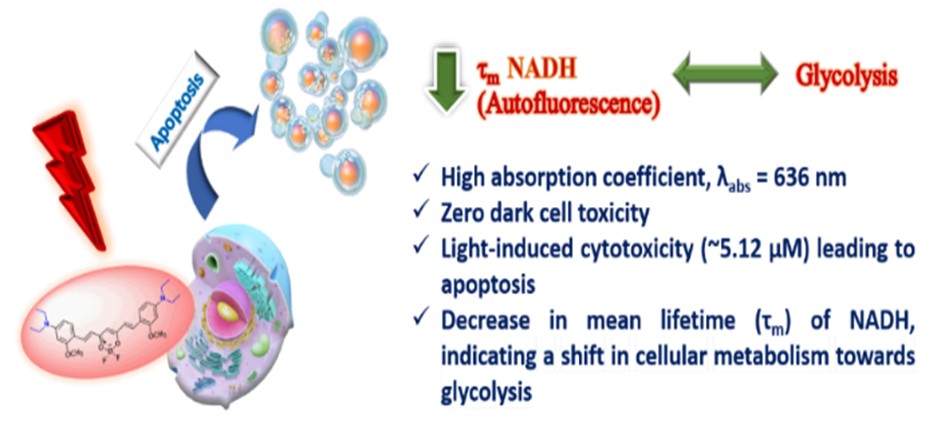
Publications: Photochem. Photobiol. Chemistry A, 457, 115902, 2024; Photodiagnosis and Photodynamic Therapy, 45, 103951, 2024
(6) Naphthalene fused BODIPY and its application in photodynamic therapy: In this work, we reported the synthesis of Naph-BODIPY Br2, having high molar absorption coefficient and excellent singlet oxygen quantum yield (ΦΔ ~ 0.50 in methanol). We also developed its nanoaggregates in water which possess high singlet oxygen generation and significant phototoxicity against human carcinoma cells with IC50 value of 4.06 µM and 4.09 µM, respectively for MCF-7 and A549 cells upon 5 min exposure of light.
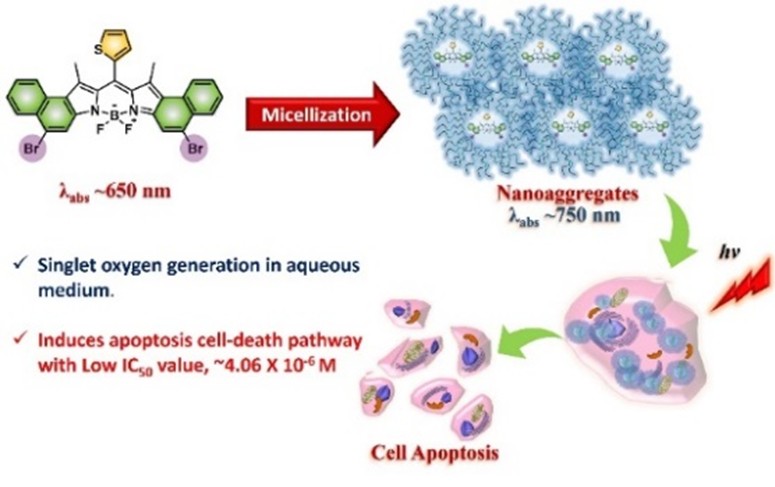
Publications: ACS Applied Bio Materials, 2024, 7, 11, 7207-7218
UM-DAE Centre for Excellence in Basic Sciences
Nalanda Building, University of Mumbai, Vidyanagari, Mumbai 400098, India.
NEST/Outreach:+9186570 26481
NEST/Admissions:+9186570 26482
General Enquiries: info@cbs.ac.in
Admissions Queries:admissions@cbs.ac.in
Web: https://cbs.ac.in